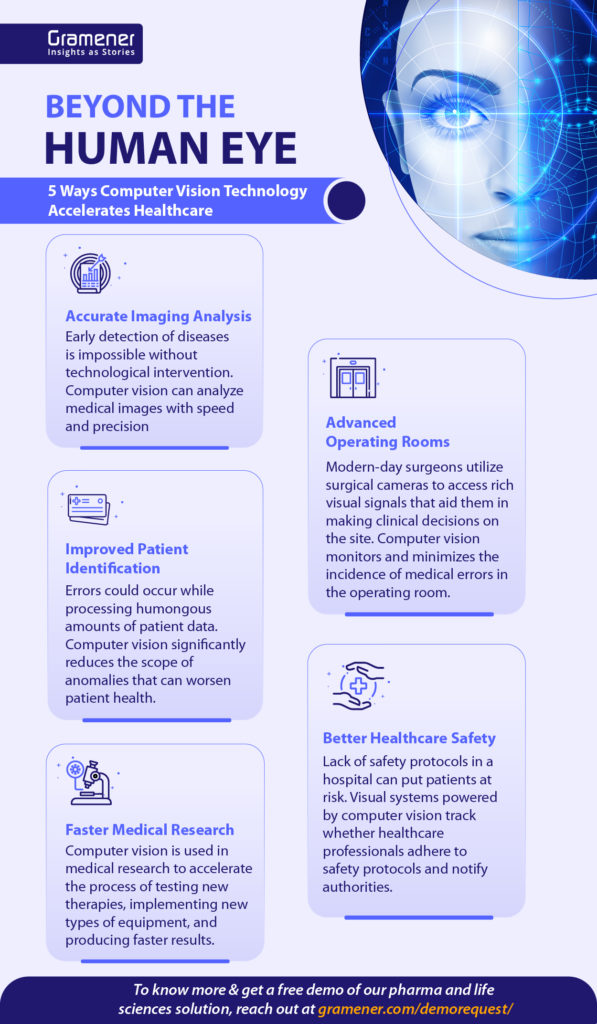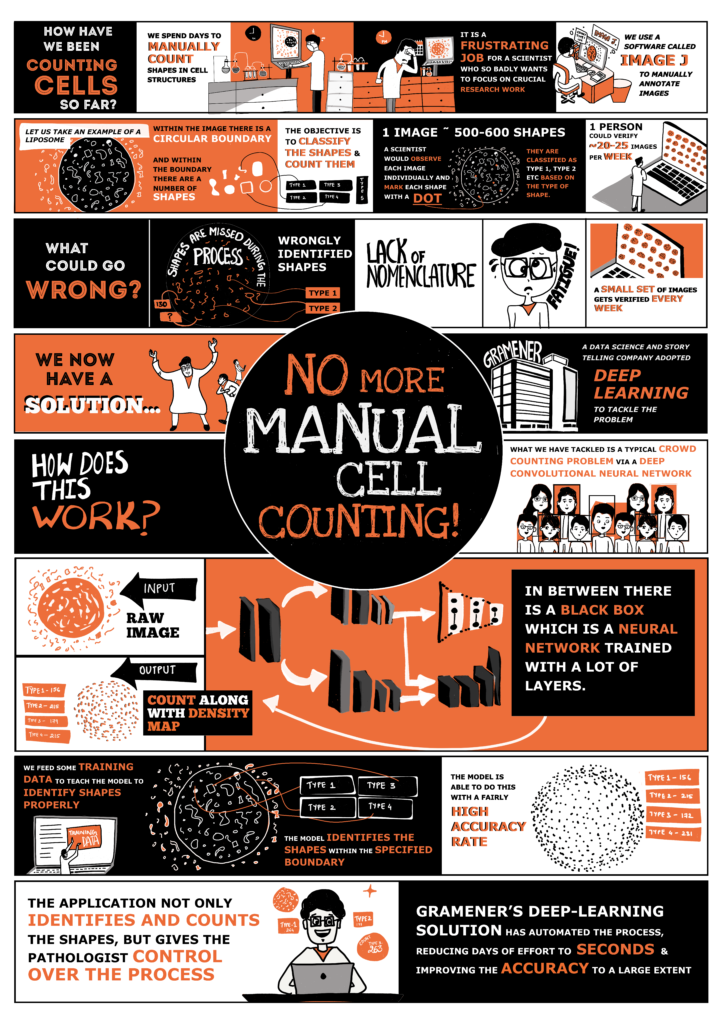Computer vision in healthcare is concerned with the interpretation of images and videos. Healthcare and Lifesciences organization around the world has witnessed a rapid transformation in recent years, powered by modern technological advancements. Detecting diseases, identifying cures, and suggesting preventive measures have become seamless with technological measures such as Computer Vision and AI.
AI-enabled technologies have been a vital contributor to improving healthcare measures. Computer vision, a subset of AI, plays a crucial role in this aspect. So, how does the healthcare segment benefit from computer vision? Let us figure it out in this article.

Table of Contents
What is Computer Vision?
A vital component of AI, computer vision digital systems work with visual data as input. The system gives insights that help analyze data better by processing images and videos. You can expect results of better quality and in a shorter period than manually analyzing the same work.
Computer vision systems are trained to understand pixels of images and videos. The system then analyses the data and interprets the findings to deliver insightful results. It happens through specialized algorithms designed for the specific purpose of analysis.
The computer vision algorithms work using the pattern recognition formula. These algorithms get trained to find a fixed pattern and add labels upon detection. There are tons of computer vision examples available to prove the prowess of technology over complex challenges. For example, you can train the system with thousands of car images. The system will create a model image of the car and detect images involving cars every time.
How Computer Vision Works in Healthcare
The healthcare segment has already benefitted much from the rise of AI. Computer vision in healthcare is now making rapid strides to deliver life-saving measures. Doctors can diagnose their patients faster and at the early stages of the disease. It thus becomes possible for them to prescribe the best treatment and monitor the progress of the disease.
It helps doctors save vital time that would otherwise be spent identifying the disease based on the various symptoms. There are several areas where computer vision is making its presence felt. These include predictive analysis, medical imaging analysis, health monitoring, and much more.
Computer vision is concerned with the interpretation of images and videos. Object identification, picture categorization, and segmentation are among the tasks involved. Recent advancements in picture categorization and object identification can help medical imaging a lot. Several research in dermatology, radiology, and pathology have shown encouraging outcomes in challenging medical diagnostic tasks. Deep-learning technologies might help doctors by providing second opinions and highlighting problematic regions in photos.
Convolutional Neural Networks (CNN) have outperformed humans in object classification challenges, in which a neural network learns to categorize the item in an image. Those convolutional neural networks (CNN) have shown good performance in transfer learning, which entails training a CNN on a large dataset (e.g., ImageNet) that is unrelated to the task at hand and then applying that knowledge to a new task.
Read our latest article: Computer Vision in Manufacturing to know about its benefits and top 10 use cases.
Benefits of Computer Vision in Healthcare
Here are the various advantages of computer vision in healthcare:
Accurate Imaging Analysis
Analyzing medical images requires speed and accuracy. Computer vision scores on both fronts as it recognizes patterns to help doctors diagnose diseases better. Computer vision in healthcare also reduces the possible scope of human errors. AI-based visual systems are adept at identifying breast cancer through the analysis of mammograms. They also enable speedy analysis, which is crucial for early disease detection.
Advanced Operating Rooms
Electronic Health Record (EHR) systems can be tedious, especially when documenting surgical procedures. It requires a lot of human input, which can often lead to errors and delays. Computer vision overcomes this problem by observing and recording the entire procedure without human intervention.
Doctors and nurses can leverage this technology to eliminate the intensive manual work and spend more time on patient care.
Improved Patient Identification
Healthcare systems witness several cases where patent identity is mistaken. Most of these cases usually get identified early, but they still pose a risk. If not detected, it might prove fatal for patients as they can receive the wrong treatment and medications. It can worsen their health and lead to other issues.
These errors can also lead to legal damage claims against hospitals that could run into millions and consequent loss of reputation. Computer vision in healthcare helps overcome all these problems.
Better Healthcare Safety
Work-related injuries and illnesses occur more in hospitals when compared to other industries in the private sector. Most injuries often occur due to negligence on the part of the medical staff. They may not use safety equipment or follow the specified protocols for safe operations.
There could also be unavoidable mishaps, but the appropriate use of technology can overcome them. Computer vision and other AI-based visual systems alert concerned authorities in the case of accidents. Computer vision in healthcare thus helps reduce the response time.
Faster Medical Research
Medical research needs to be swift for better diagnosis and treatment of diseases. It is usually time-consuming and remains prone to prejudice, leading to errors in results. Computer vision speeds up the process without any bias.
Researchers can thus identify diseases at a much quicker pace. They can then formulate medicinal treatment better for effective results.

Computer Vision in Healthcare Use Cases
Here are the various computer vision applications in the healthcare and life sciences field.
Automated Cell Counting
One of the best ways to analyze cell culture conditions is by counting cells. It gives insights into cell density. Doing it manually is an option with the help of a microscope. However, the method remains prone to errors, leading to concerns about the reliability of results.
Results can significantly vary based on the concentration levels and experience of the examiner. Computer vision in healthcare automates the counting process and eliminates accuracy issues.

Medical Imaging
Medical imaging helps doctors diagnose the disease accurately and offers better treatment to the patient. The technology creates a visualization of organs and tissues to assist doctors. They can then identify issues in the patient’s organs and take corrective measures. Some examples of medical imaging include endoscopy and X-ray.
Tumor Detection
Detecting brain tumors is possible with the help of computer vision and deep learning applications. Detection of these tumors early is critical to limit their spread to other parts of the body, leading to complications if left untreated. Computer vision makes detection easy and without wasting much time. There are also no possibilities of errors resulting from manual work.
Cancer Detection
A computer vision model can seamlessly identify moles from melanomas with better accuracy than humans. Similarly, skin cancer, which is difficult to detect because of its similarities with other skin problems, remains easily detectable using computer vision in healthcare. Doctors can identify lesions that can cause cancer and start remedial measures.
Breast cancer is another ailment where computer vision is helpful. When combined with deep learning algorithms, it can detect cancerous tissues. The chances of human errors are also less as the entire process remains automated.
Medical Training
Computer vision can enable better medical skill training besides assisting in diagnosis. Doctors usually rely on practical experience to advance their skills. However, computer vision offers simulation platforms where doctors can gain knowledge and sharpen their skills. Computer vision in healthcare ultimately helps them improve their skills.
Timely Detection of Underlying Medical Conditions
Timely detection of fatal diseases like cancers and tumors is critical. When these get detected at the early stage, the survival chances of patients increase substantially. A computer vision model, trained by millions of images, helps identify patterns accurately. It thus becomes possible for doctors to detect diseases in time and begin the treatment early for better possibilities.
Monitoring Health
Doctors are increasingly using AI-based applications to check the health and wellness of patients. Computer vision calculates the blood loss during surgeries and the amount needed to maintain health. It helps improve decision-making abilities, especially in critical situations.
COVID-19 Diagnosis
Computer vision in healthcare is also contributing to fighting the coronavirus pandemic. The technology can help doctors diagnose viral infections early and propose mitigation measures. Some applications include radiography images through digital X-rays. Patients do not have to wait for RT-PCR tests that take time. Doctors can thus begin quick treatment by detecting the disease in time.
Mask Detection
Wearing face masks in public is vital to control the spread of Covid-19. As the movement of people outdoors has increased, they must always wear a mask. Computer vision helps track people to see if they have a mask on their faces. Furthermore, the technology can also detect if their mask is at the correct spot. The system is trained using millions of images to accurately flag people with or without face covering.
Remote Monitoring of Patients
Patients usually want to move to their homes after staying in the hospital for a while. Remote monitoring of patients becomes a task for doctors in such cases. However, computer vision overcomes this problem by giving doctors the necessary support to track patients’ health remotely. It allows patients to isolate themselves in their homes and save costs.
X-Ray Analysis
Computer vision systems get trained on image databases to identify attributes. There are myriad applications of X-ray technology in the medical field. It helps in the detection of tumors, cancer, and Covid-19. Besides these use cases, X-ray technology is also ideal for MRI construction and surgeries.
When we talk of dentofacial treatment, the current procedures rely on manual analysis of X-ray scans. Manual efforts always remain prone to errors and consume a lot of time. Automating the process with the help of computer vision eliminates both problems.
CT Scan and MRI
Computer vision’s ability to identify patterns in images helps doctors beyond X-rays. It helps in the timely detection of various diseases. Physicians can also get support for CT scans and MRI images. Deep learning algorithms and computer vision, combined with neural network models, help classify image databases. The system can then detect abnormalities in images and flag them for further action.
Read More: Computer Vision for Defect Detection in Manufacturing
Bottomline
Computer vision has limitless potential to transform the healthcare industry for the better. Computer vision in medical imaging also helps doctors diagnose diseases early. It ultimately proves to be a life-saving step for patients as they can receive swift treatment and have much better chances of survival.
Besides medical imaging, computer vision in healthcare has several other use cases. Doctors can use such systems for their training and skill-building purposes. Furthermore, it also helps in the remote monitoring of patients. Making the best use of computer vision thus becomes critical to leveraging its potential.
Gramener is a leading provider of computer vision solutions to healthcare institutions and research organizations. Our offerings help overcome challenges and achieve the desired business objectives.
Contact us for custom built low code data and AI solutions for your business challenges and check out computer vision solutions built for our clients, including Fortune 500 companies. Book a free demo right now.

